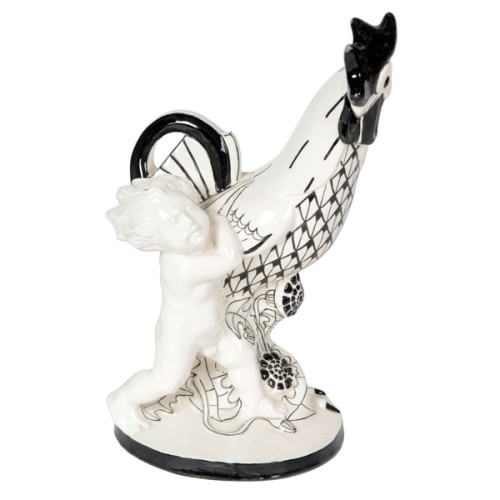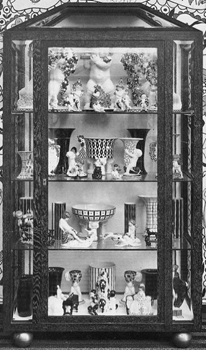Product Description
Michael Powolny / Wiener Keramik / Wiener Werkstaette / Vienna Secession “Putto mit Hahn” c. 1910



MICHAEL POWOLNY (1871-1954) Austria
BERTOLD LÖFFLER (1874-1960) Austria
WIENER KERAMIK Vienna
Putto mit Hahn c. 1910
Glazed white earthenware handpainted with black enamel
Marks: MP (impressed artist’s monogram), WK (impressed company logo in a square), original Wiener Keramik paper label
Exhibited: Frühjahrsausstellung Österreichischer Kunstgewerbe in Österreichisches Museum für Kunst und Industrie (MAK museum), Vienna, 1912.
Model illustrated: Deutsche Kunst und Dekoration, Vol. XXXI, October 1912 – March 1913, n.p.; Michael Powolny: Keramik und Glas aus Wien 1900 bis 1950, Elisabeth Frottier (Vienna: Böhlau Verlag, 1990) 1912 photograph with the cock sculpture displayed in vitrine from Frühjahrsausstellung Österreichischer Kunstgewerbe, illus. 4, p. 15 and illus. 27, p. 54, cat. no. WV92.
H: 9 1/8″
Price: $7,950
Michael Powolny / Wiener Keramik / Wiener Werkstaette / Vienna Secession “Putto mit Hahn” c. 1910
Edward Spencer attr. (1872-1938) UK
Artificer’s Guild (1901-42) UK
Pair of candlesticks circa 1910.
Handwrought iron with a squared central support terminating in a attenuated vine like wrap.
H: 10 1/2″ x Dia: 5 1/2″
The Artificers’ Guild Ltd was founded in 1901 by the metalwork and enameler Nelson Dawson (1859-1942). It was one of the few guilds inspired by the Arts and Crafts movement to enjoy real commercial success, and remained in operation until 1938. It was bought out in 1903 by the Birmingham entrepreneur Montague Fordham and established on a more commercial footing, producing domestic metalwork, church plate and furnishings, presentation plate and jewelry.
Fordham promoted Edward Spencer (1873-1938), previously Dawson’s principal designer, to be Director of the Guild’s workshop in Hammersmith. The Guild also had a showroom originally located just off Regent Street. Spencer died in 1938, shortly after the firm was wound up. During its existence, the Guild operated as a substantial business, employing over 40 staff at its peak, including a large number of skilled craftsmen, many of whom would have been trained in the Guild’s workshop. Although unacknowledged for much of the 20th century, the Guild is now recognized as an important producer of high quality metalwork and jewelry during this period.
JOSEF HOFFMANN (1870-1956) Austria
WIENER WERKSTÄTTE (1903-1932) Vienna
Fluted serving tray c. 1928
Handwrought silver plated brass, gilt interior, hand hammered swirled fluting, scalloped edge
Marks: MADE IN AUSTRIA (in a square), JH monogram, WIENER WERK STÄTTE (in a square)
Model illustrated: Josef Hoffmann: Ornament zwischen Hoffnung und Verbrechen (Wien: Herausgeber, 1987) p. 185.
Related models illustrated: Wiener Werkstätte Design in Vienna 1903-1932, Werner J. Schweiger (New York,1984) pp. 62,66; Josef Hoffmann Designs, ed. Peter Noever, MAK and Prestel-Verlag: Munich, 1992) pp. 172, 174, 189.
H: 1” x D: 8”
Price: $5,500
